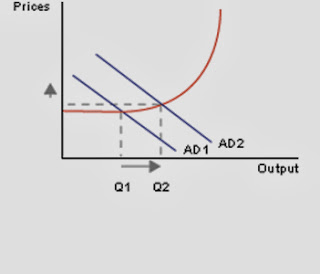Reflationary
policies and Deflationary policies
Keynesians
- Policies
The other sections about Keynesians show that they believe
that the economy can settle at any equilibrium. This means that they recommend
that the government gets actively involved in the economy to manage the level
of demand. You will then be stunned to learn that these policies are known as
demand-management policies.
Demand management means adjusting the level of demand to try
to ensure that the economy arrives at full employment equilibrium. If there is
a shortfall in demand, such as in a recession (a deflationary gap) then the
government will need to reflate the economy. If there is an excess of demand,
such as in a boom, then the government will need to deflate the economy.
Reflationary
policies
Reflationary policies to boost the level of economic activity
might include:
* Increasing the
level of government expenditure
* Cutting taxation
(either direct or indirect) to encourage spending
* Cutting interest
rates to encourage saving
* Allowing some
money supply growth
The first two policies would be considered expansionary fiscal
policies, while the second two are expansionary monetary policies. The impact
of them should be to reduce aggregate demand and therefore the level of output.
The diagram below shows this:
[Reflationary
policies]
The reflationary policies have boosted the level of output
from Q1 to Q2. The impact on the price level has been small, though if demand
increased any more it may well be inflationary.
Deflationary
policies
Deflationary policies to dampen down the level of economic
activity might include:
* Reducing the
level of government expenditure
* Increasing
taxation (either direct or indirect) to discourage spending
* Increasing
interest rates to discourage saving
* Reducing money
supply growth
The first two policies would be considered contractionary
fiscal policies, while the second two are contractionary monetary policies. The
impact of them should be to reduce aggregate demand and therefore the level of
output. The diagram below shows this:
[Deflationary
policies]
The initial level of aggregate demand was inflationary -
prices were increasing rapidly. However,
the deflationary policies have reduced demand to AD2 and thus reduced the level
of inflation.


No comments:
Post a Comment